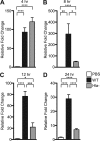Host response signature to Staphylococcus aureus alpha-hemolysin implicates pulmonary Th17 response
- PMID: 22733574
- PMCID: PMC3418743
- DOI: 10.1128/IAI.00191-12
Host response signature to Staphylococcus aureus alpha-hemolysin implicates pulmonary Th17 response
Abstract
Staphylococcus aureus pneumonia causes significant morbidity and mortality. Alpha-hemolysin (Hla), a pore-forming cytotoxin of S. aureus, has been identified through animal models of pneumonia as a critical virulence factor that induces lung injury. In spite of considerable molecular knowledge of how this cytotoxin injures the host, the precise host response to Hla in the context of infection remains poorly understood. We employed whole-genome expression profiling of infected lungs to define the host response to wild-type S. aureus compared with the response to an Hla-deficient isogenic mutant in experimental pneumonia. These data provide a complete expression profile at 4 and at 24 h postinfection, revealing a unique response to the toxin-expressing strain. Gene ontogeny analysis revealed significant differences in the extracellular matrix and cardiomyopathy pathways, both of which govern cellular interactions in the tissue microenvironment. Evaluation of individual transcript responses to Hla-secreting staphylococci was notable for upregulation of host cytokine and chemokine genes, including the p19 subunit of interleukin-23. Consistent with this observation, the cellular immune response to infection was characterized by a prominent Th17 response to the wild-type pathogen. These findings define specific host mRNA responses to Hla-producing S. aureus, coupling the pulmonary Th17 response to the secretion of this cytotoxin. Expression profiling to define the host response to a single virulence factor proved to be a valuable tool in identifying pathways for further investigation in S. aureus pneumonia. This approach may be broadly applicable to the study of bacterial toxins, defining host pathways that can be targeted to mitigate toxin-induced disease.
Figures





Similar articles
-
Alpha-toxin facilitates the generation of CXC chemokine gradients and stimulates neutrophil homing in Staphylococcus aureus pneumonia.J Infect Dis. 2008 Nov 15;198(10):1529-35. doi: 10.1086/592758. J Infect Dis. 2008. PMID: 18823272
-
Vaccine protection against Staphylococcus aureus pneumonia.J Exp Med. 2008 Feb 18;205(2):287-94. doi: 10.1084/jem.20072208. Epub 2008 Feb 11. J Exp Med. 2008. PMID: 18268041 Free PMC article.
-
The role of IL-27 in susceptibility to post-influenza Staphylococcus aureus pneumonia.Respir Res. 2015 Feb 5;16(1):10. doi: 10.1186/s12931-015-0168-8. Respir Res. 2015. PMID: 25651926 Free PMC article.
-
Immunopathogenesis of Staphylococcus aureus pulmonary infection.Semin Immunopathol. 2012 Mar;34(2):281-97. doi: 10.1007/s00281-011-0291-7. Epub 2011 Oct 31. Semin Immunopathol. 2012. PMID: 22037948 Free PMC article. Review.
-
Cell targeting by the Staphylococcus aureus pore-forming toxins: it's not just about lipids.Trends Microbiol. 2014 Jan;22(1):21-7. doi: 10.1016/j.tim.2013.10.004. Epub 2013 Nov 11. Trends Microbiol. 2014. PMID: 24231517 Free PMC article. Review.
Cited by
-
Gut-Lung Microbiota Interaction in COPD Patients: A Literature Review.Medicina (Kaunas). 2022 Nov 30;58(12):1760. doi: 10.3390/medicina58121760. Medicina (Kaunas). 2022. PMID: 36556962 Free PMC article. Review.
-
Staphylococcus aureus α-toxin: nearly a century of intrigue.Toxins (Basel). 2013 Jun;5(6):1140-66. doi: 10.3390/toxins5061140. Toxins (Basel). 2013. PMID: 23888516 Free PMC article. Review.
-
Toxin-Triggered Interleukin-1 Receptor Signaling Enables Early-Life Discrimination of Pathogenic versus Commensal Skin Bacteria.Cell Host Microbe. 2019 Dec 11;26(6):795-809.e5. doi: 10.1016/j.chom.2019.10.007. Epub 2019 Nov 26. Cell Host Microbe. 2019. PMID: 31784259 Free PMC article.
-
Messing with the Sentinels-The Interaction of Staphylococcus aureus with Dendritic Cells.Microorganisms. 2018 Aug 15;6(3):87. doi: 10.3390/microorganisms6030087. Microorganisms. 2018. PMID: 30111706 Free PMC article. Review.
-
Staphylococcus Aureus Surface Protein G is An Immunodominant Protein and a Possible Target in An Anti-Biofilm Drug Development.Open Microbiol J. 2018 Apr 30;12:94-106. doi: 10.2174/1874285801812010094. eCollection 2018. Open Microbiol J. 2018. PMID: 29785216 Free PMC article.
References
-
- Athanassa Z, Siempos, Falagas ME. 2008. Impact of methicillin resistance on mortality in Staphylococcus aureus VAP: a systematic review. Eur. Respir. J. 31:625–632 - PubMed
-
- Bartlett AH, Foster TJ, Hayashida A, Park PW. 2008. Alpha-toxin facilitates the generation of CXC chemokine gradients and stimulates neutrophil homing in Staphylococcus aureus pneumonia. J. Infect. Dis. 198:1529–1535 - PubMed
-
- Benjamini Y, Hochberg Y. 1995. Controlling the false discovery rate: a practical and powerful approach to multiple testing. J. R. Statist. Soc. B 57:289–300
Publication types
MeSH terms
Substances
Grants and funding
LinkOut - more resources
Full Text Sources
Molecular Biology Databases
Research Materials

